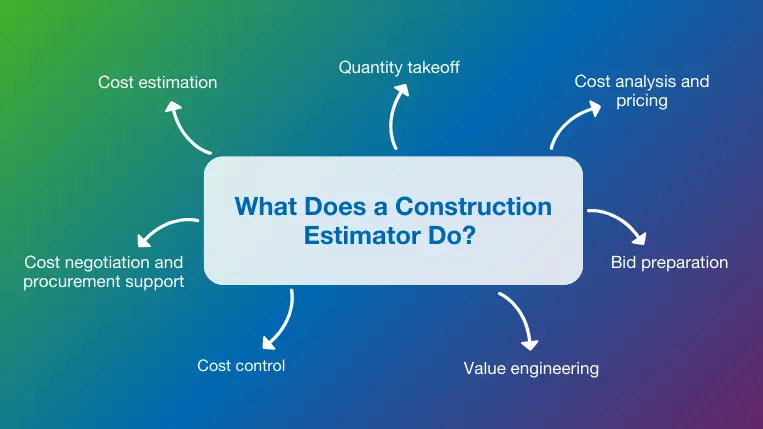11 mins read
What is a Construction Estimator? A Closer Look

- What is a Construction Estimator?
- What Does a Construction Estimator Do?
- Key Construction Estimator Skills
- How Much Can You Earn as a Construction Cost Estimator?
- How Do I Become a Construction Estimator?
- What Challenges Do Construction Estimators Commonly Face?
- What Kind of Software Do Construction Estimators Use?
- Final Thoughts
Over the last two weeks, we have been discussing the different professionals, technologies, and processes that comprise the construction industry. We have already delved into the roles of the quantity surveyor, the HSEQ manager, the construction architect, and others. Today, we explore the role of the construction estimator in the industry.
Construction cost estimation is the foundation upon which projects in the construction industry are created, and construction estimators are critical to the success of these projects. Acting as the link between the original project idea and its financial viability, these professionals evaluate all components of the project to offer an accurate estimate of its cost.
Let’s take a closer look into what construction estimators do, the challenges they face, the key skills needed to become one, and more.
What is a Construction Estimator?
A construction estimator is a professional in charge of calculating the costs of a project, considering time, materials, equipment, and labor. They ensure the project has sufficient resources by performing accurate estimations and cost analysis.
The first key skill a construction project estimator must master is how to read blueprints, and following that, how to measure and assess the site-based requirements. Estimators enable efficient construction cost control – by calculating the costs of material, labor, equipment, and other costs. That’s why strong math skills are very important if you want to pursue a career in estimating. Calculating costs assists contractors and customers in determining the project’s viability, developing budgets, and submitting correct bids for projects.
Collaboration is another important aspect of a construction cost estimator’s role. They regularly liaise with other construction professionals during the bid preparation phase. Construction estimators can work with engineers and architects to review plans for a project, and they often work with material and equipment vendors to determine the prices of materials and labor rates. They also need to present their finished estimate in detail to various stakeholders.
What Does a Construction Estimator Do?

A construction project estimator fulfills various roles which are critical to the success of a construction project. Here are the main construction estimator responsibilities:
Cost Estimation & Bid Preperation
Central to an estimator’s work is estimating how much the total project will cost. They thoroughly evaluate all aspects of the project budget, including labor, materials, equipment, overhead, and any contingencies that may develop.
Quantity Takeoff
These professionals also determine how much materials are needed for a project by doing a quantity takeoff. They examine the plans and requirements to determine the precise amounts of building supplies contractors will need to finish the project, like wood, steel, and concrete.
Cost Analysis and Pricing
The construction cost estimator also studies the prices of supplies, labor, and services that subcontractors provide to them. To maintain cost competitiveness, they need to monitor market prices and adjust the project’s cost structure accordingly throughout the project’s progress.
Bid Preparation
They are vital in helping contractors prepare bids. As part of the construction bidding process, they compile all the cost data, specifications, and timelines needed for the bid proposal, all the while making sure they offer competitive prices while striving for profitability.
Value Engineering
The estimator is also involved in the construction value engineering process, where they identify cost-saving opportunities without compromising on quality. This may include proposing alternative construction techniques or materials that might achieve the project’s objectives at a lower price.
Cost Control
Construction budget management is not typically a key responsibility for a construction estimator. However, depending on the size and structure of the company, they may take on this task or play a supporting role. In such cases, they might assist in monitoring expenses and comparing them to the original estimates as the project progresses. This support helps prevent budget overruns and ensures the project stays aligned with the estimated cost parameters.
Cost Negotiation and Procurement Support
A construction project estimator often supports the procurement team by negotiating prices with suppliers and subcontractors. To further manage total project costs, their knowledge of market trends and pricing structures is crucial for achieving competitive prices for supplies and services.
Key Construction Estimator Skills

To thrive in the world of construction, estimators need a special combination of technical knowledge, analytical thinking, and people skills. The following are the most important estimator qualifications:
Technical Proficiency
They must have an in-depth knowledge of all relevant technologies, processes, and materials, as being proficient in project management systems and digital tools is a must for doing precise construction takeoffs and cost analyses. Construction estimators must have a solid grasp of technical concepts to interpret construction laws, requirements, and blueprints.
Time Management
Estimators often face the challenge of working under pressure to provide bids and cost estimates before a project begins. That is why time management skills are essential (especially when juggling many projects at once). Tight deadlines are a daily part of an estimator’s job, where, despite the pressure, they must remain methodical, set priorities, and ensure accuracy.
Communication
Efficient communication in construction projects is the cornerstone of success, and as such, these professionals need strong communication skills. To get everyone on the same page about the project’s scope and budget, they must collaborate with architects, engineers, construction project managers, contractors, and suppliers. They also need to communicate and justify their estimates to stakeholders, customers, or upper management.
Mathematical Skills
If you want to be a successful estimator, you need to have an excellent knowledge of algebra, geometry, and basic statistics, as you must be able to calculate areas, volumes, and quantities to ensure all measurements are precise. And for performing cost analysis, pricing, and financial forecasting, solid math skills are crucial.
Data Analysis
Estimators must be able to analyze various sources of data in order to interpret the conditions of the market, trends in costing, and data about how the project is performing. This is how they spot trends and fine-tune their estimations.
Attention to Detail
Because construction projects involve many components and variables, attention to detail is essential. Even one small oversight or miscalculation on the estimator’s part can have a very negative financial impact. That is why one of the most important things an estimator must remember is to thoroughly examine the project’s plans, specs, and cost data to make sure they haven’t missed anything, before they settle on a final estimate.
How Much Can You Earn as a Construction Cost Estimator?
The average construction estimator salary in the United States is currently $71,000 per year, with the possibility to increase up to $ 115,000. In the United Kingdom, the average salary annually is £43,564 ($57,921). Salaries vary in different countries, and in the United States, also varies from state to state. Salaries also vary according to your specific qualification.
Construction estimators can be self-employed or work for small, medium or large companies, and they generally work eight-hour shifts (08:00 to 17:00) five days a week. They spend most of their time in the office but can also spend time on-site.
How Do I Become a Construction Estimator?
There are different paths you can take to become a construction cost estimator. It usually starts by earning a bachelor’s degree in a related field, like construction management, civil engineering, or construction science. These can equip you with valuable knowledge and skills and, as a bonus, increase your appeal with recruiters or employers. It typically takes around four years to complete an undergraduate degree in construction management or a related field.
You will also need to get hands-on experience in the construction industry after graduating. You will most probably start out in an entry-level position, like a junior estimator or assistant project manager. These positions will help you get your head around the intricacies of construction projects, while at the same time familiarizing yourself with cost estimation.
A way to demonstrate your competence and commitment to your career development is to earn professional certifications. In the US, you can try getting a certification like the Certified Professional Estimator (CPE) from the American Society of Professional Estimators or the Certified Cost Professional (CCP) from AACE International. In the UK, you can get a certification from the UK Professional Development Academy.
Also make sure you stay updated with the latest trends, techniques, and software in construction estimation. Attend workshops, seminars, and conferences to hone your skills and rub shoulders with other industry professionals (this may also lead to job opportunities).
What Challenges Do Construction Estimators Commonly Face?

While a rewarding career choice, this profession has many challenges, both professional and personal. Here are the key pain points construction estimators face in their daily work.
Poor Communication
One of the hardest challenges they face is poor or delayed information from stakeholders. Estimators rely on up-to-date data to make informed decisions and need to provide accurate figures and forecasts regularly. But when information is scattered, siloed or arrives late, it can lead to inefficiencies and errors in cost estimation.
Team Alignment
For a construction project to be successful, the different stakeholders must have a common vision or goal in mind. This, however, is easier said than done, and construction cost estimators often have the difficult task of mediating between conflicting priorities, like budget constraints or ideas for the project’s design.
Driving Innovation While Managing Risks
To stay competitive in the construction industry, you need to constantly be innovative. However, driving innovation while managing the risks is a delicate balancing act. Construction estimators must keep their eye on emerging technologies, new construction methods, and the latest materials, all while ensuring they keep costs under control.
Navigating Global Market Fluctuations and Regulatory Changes
Global market conditions affect the construction industry heavily. There are constant fluctuations in material costs, and supply chain disruptions and labor shortages are commonplace. A person in this role must continuously stay abreast of these variables and adjust estimates accordingly to prevent budget overruns. In addition, cost projections can be complicated by evolving regulations and local building codes, which further adds complexity to the estimating process.
What Kind of Software Do Construction Estimators Use?
To tackle the challenges mentioned above and to optimize processes to stand out from competitors, construction estimators support themselves with various tools and technologies. The most common ones include:
Takeoff and Estimating Software
Traditionally, architects would deliver paper or digitalized drawings, and the estimator would do a manual takeoff from them. While many still use this method, these days it’s much easier to use BIM cost estimation software to enhance processes and make them more efficient. Using this software leads to increased accuracy, time efficiency, better cost efficiency, improved communication, and more.
An example of BIM estimating software is RIB CostX, a unified costing platform that seamlessly connects BIM and 2D takeoff and estimating with carbon accounting.
With CostX, cost estimators have an easy-to-use tool that reduces errors and improves accuracy. It enables 2D takeoffs with a single click, which increases speed. Its advanced 3D/BIM support means that customers get more accurate calculations, considerable time savings, and improved quality within their estimates.
Cost Management Software
Cost management software allows estimators to generate and build accurate, reliable estimates, manage subcontractors and suppliers, forecast income and spending, and track budgets and bid changes, to name a few.
An example of this software is RIB BuildSmart, a powerful tool to monitor and optimize costs throughout projects with collaboration and technology.
Estimators using BuildSmart can accurately and easily compare actual costs to project budgets in real-time, allowing for timely management interventions and leading to improved margins and a competitive advantage. The platform’s real-time cost reporting feature ensures that your true activity-based costs are always on hand.
Collaboration Software
Construction collaboration software empowers teams to collaborate and communicate effectively, thereby ensuring projects are completed safely, efficiently, and on time, regardless of where in the world teams are located.
RIB CX is an excellent example of this type of software. CX acts as a centralized communication hub that allows teams to store and capture all activity on the dashboard for real-time follow-ups and reviews.
It is designed to increase efficiency and productivity in the office and on-site and to support every aspect of your business operations.
BIM Software
Estimation for construction purposes can be done through using comprehensive BIM management software. This specialized digital tool allows users to map the components of a 3D building model to materials and labor, as well as equipment costs. It helps the project come to life in a digitized environment, making it possible to extract detailed information that you would otherwise not be able to do using traditional estimation methods.
A great example of this is our global leading BIM estimating software, RIB CostX BIM, which has been developed to facilitate and automate the takeoff and estimating process.
Apart from viewing and conducting quantity takeoff from 3D model/BIM within the program, it also supports 5D BIM using information from the model live-linked to user-defined rate libraries and workbooks. CostX also supports various drawing files and external rate information and can be exported to several formats.
Final Thoughts
As you learned throughout this blog post, the work of construction estimators is a cornerstone of every successful construction project. They manage risks, allocate resources effectively, and ensure that costs are accurately projected.
To stay ahead of the game, estimators must use cutting-edge technology like RIB CostX to improve accuracy, speed up processes, and ultimately ensure a successful project outcome. If you are ready to experience the benefits that our professional estimating software has on offer, get your free demo for RIB CostX today!
Get My Free RIB CostX Demo Now

Most Recent
11 mins read
10 mins read
10 mins read
29 mins read
Blog Categories

Ebook











